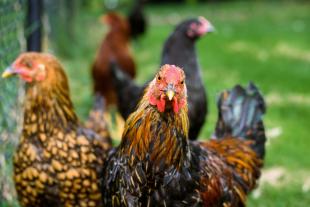Cal Poly Study Finds Light Pollution Increases Likelihood of Spreading West Nile Virus
A new study from Cal Poly and the University of South Florida (USF) is the first to provide direct evidence that light pollution is driving infectious disease patterns in nature.
The research team previously determined mosquitoes and birds are attracted to artificial light at night, greatly enhancing the likelihood that the insects will spread West Nile virus to animals and humans.
Their new findings published this week in the “Proceedings of the Royal Society B” are in contrast to previous studies that have blamed urbanization due to its human population density and breeding hotspots, such as drainage systems.
“Research from our team members at USF had shown in lab-based studies that light pollution could potentially influence West Nile virus risk,” said Clinton Francis, a Cal Poly biology professor and corresponding study author, “but our study is the first to show how light pollution can affect risk of West Nile virus in the real world, and better explains patterns of risk than environmental variables previously thought important.”

West Nile virus is the most common and serious insect-transmitted disease in California. Between 2003 and 2020, there were more than 7,200 reports of infections that resulted in 320 human deaths, according to the state Department of Public Health.
Mosquitoes feeding on the blood of birds infected with West Nile virus transmit the disease to humans, horses and chickens. In 2020, there were 231 human cases in 26 counties stretching from Shasta to San Diego. The mosquitoes that transmit West Nile virus are found throughout the state.
The research team, which included collaborators from the University of Georgia, modeled West Nile virus exposure data from the Florida Department of Health.
They studied 6,468 antibody samples from sentinel chickens collected between June and December over four years from 105 coop locations throughout the Sunshine State. Researchers found most cases of West Nile virus were present in chickens exposed to low levels of light compared to those surrounded by unpolluted and intensely light-polluted areas.
“We think that we got a peak at low levels of light because of the many ways that light pollution is probably driving risk of infection,” said Marty Martin, professor of disease ecology in the USF Center for Global Health and Infectious Disease Research, a Tampa-based facility that works to improve the health of people afflicted by infectious diseases through improved diagnostics, treatments and preventive mechanisms.
Many county health departments use sentinel chickens as a surveillance mechanism to monitor for West Nile virus and other mosquito-borne diseases. They typically don’t get sick from the virus and can’t transmit it to mosquitoes, people or other birds. Counties strategically place coops in locations that best represent the local human population, helping identify where to direct mitigation efforts that can prevent the spread of infection.
Prior research showed that light pollution affects birds’ immune responses to West Nile virus. This light pollution may also increase the number of mosquitoes in an area because most insects are attracted to light. Birds may in turn be attracted to these areas to feed on the mosquitoes, that also bite the birds, thus increasing the risk of West Nile virus spreading in that location.
These findings support a 2019 study from USF that found exposure to artificial light increases the infection period of wild birds, increasing the potential of West Nile virus outbreaks by 41 percent.




